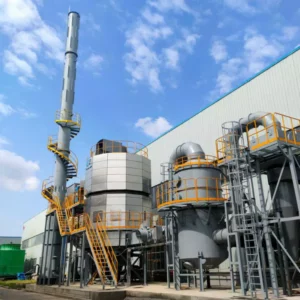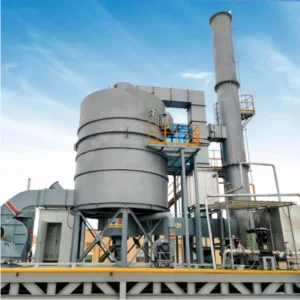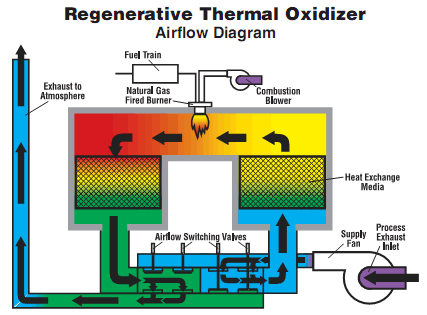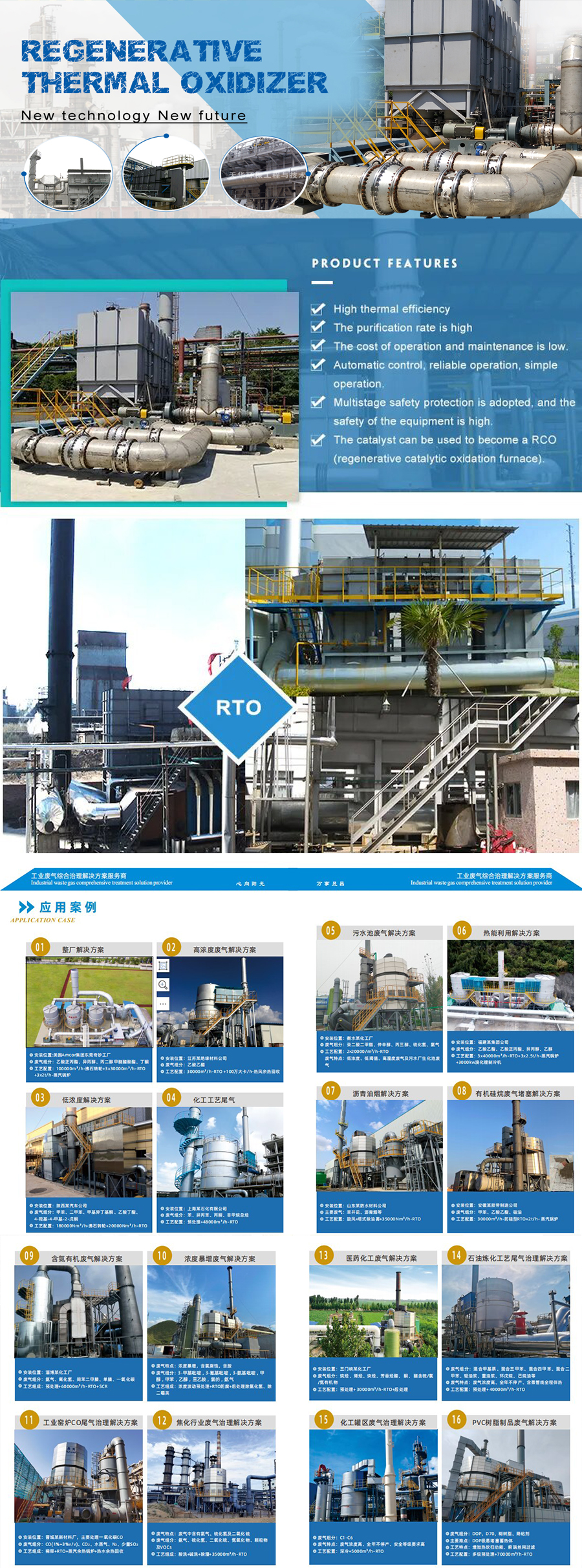Basic Info.
Model NO.
RTO
유형
Environmental Monitoring Instrument
Brand
Raidsant
Condition
New
Clean Efficeincy
99.8%
Application
Chemical Industry
Main Function
Waste Gases Removal
Trademark
Raidsant
Transport Package
Film Wrapped
Origin
ZheJiang China
Product Description
HangZhou Raidsant Machinery Co.;,; Ltd.; is majored in developing and manufacturing innovativepowder cooling pelletizing machinery and related industrial waste gas treatment machine.; With nearly 20 years’ production history,; we have a good market in more than 20 provinces in China,; and some of our products were exported to Saudi Arabia,;Singapore,;Mexico,; Brazil,;Spain,; America,; Russia and Korea,; etc.;
Specifications:;
* More compact than the existing facilities
* Low-operation costs
* Long lifespan of facilities
* No changes in pressure
Purpose:;
Energy-saving system that burns volatile organic compound (VOC); and waste gas by using heat,; and it collects over 99.;8% of waste heat of exhaust gas by using ceramic regenerative materials (catalyst); with large surface area and low-pressure loss.;
Applications:;
1.; Painting drying process
2.; metal printing process
3.; fiber drying process
4.; adhesive tape process
5.; waste treatment process
6.; semiconductor manufacturing process
7.; smoke,; confectionary and baking process
8.; petrochemical process,;
9.; medicine and food manufacturing process,;
10.; other VOC generating process
Merits:;
* More compact than the existing facilities
* No changes in pressure
* High-heat recovery rate (over 95%);
* Perfect VOC treatment (over 99.;8%);
* Long lifespan of facilities
* Low-operation costs
* Able to be manufactured in circle or quadrangle
General Descriptions and Features:;
1.; Operating principle
Operation method that continuously changing discharges by rotating the Rotary Valve
2.; Process Pressure Change
No pressure change because wind direction changes in order by the Rotary Valve rotation
3.; Investment Costs
Around 70% of Bed Type
4.; Installation Space
It is single vessel so it is compact and requires less installation space.;
5.; Maintenance
It is easy to maintain it because Rotary Valve is the only 1 moving part.;
Rotary Valve’s sealing part is rarely worn out because it rotates at low speed.;
6.; Stability
No risks in the process because it is always opened even when the Rotary Valve has troubles.;
7.; Treatment Efficiency
Treatment efficiency maintains because sealing part is rarely worn out even if it is operated for a long time.;
Address: No.3,Zhenxin Middle Road, Economic Development Zone,HangZhou,ZheJiang
Business Type: Manufacturer/Factory, Trading Company
Business Range: Chemicals, Electrical & Electronics, Manufacturing & Processing Machinery, Security & Protection
Management System Certification: ISO 9001
Main Products: Pelletizer, Flaker, Pastillator, Granulator, Chemical Pelletizer, Vocs
Company Introduction: HangZhou Raidsant Machinery Co., Ltd. ., previously called HangZhou Xinte Plastic Machinery Factory is majored in producing innovative plastic recycling machinery. With nearly 20 years′ experience, we have a good market in 20 provinces in China, and some of our products were exported to Indonesia, Russia and Vietnam, etc. Our main products include DZ Type Pastillator, waste tire recycling line, Big Calibre Plastic Pipe shredders recycling line, continuous annealing tin-coation machine, QX type PET, PE & hull washing line, SDP double rails plastic recycling crusher, SJ hot cutting granule making unit, PVC tube (cinquefoil) product line, PVC Odd-shaped material product line for door and window, granule product line in water and Shredder for plastics and recycling. We acquired 5 technical patents.
Our corpotation lays emphsis on thchnical reconstruction, imports advanced technology from home and abroad, and develops new products constantly. Our tenet is challenging for hight quality, offering the best products. We are making efforts to realize our slogan. Satisfying our customers is our everlasting pursuit.
We are looking for the oversea customers or agents. If you are interested in our proposal, please let us know which of our products is the most likely to appeal to you or your customers. We should be very grateful if you give us some ideas of the marketprospects for our products. We hope to hear favorable information from you soon! It is our goal that we wish we could buid a good relationship with you now or in the near future. Please do not hesitate to contact us if you have any question or request.
We also sincerely welcome you to our company to discuss business and negotiate with us. For further expanding our market and customers, our company welcomes customer from domestic and aboard in an new-brand gesture on the basis of full-new mangement conception—quality, honour, service. We are looking for ISO 90001 mangement quality system to meet with our customers requirement!

Do regenerative thermal oxidizers require continuous monitoring and control?
Yes, regenerative thermal oxidizers (RTOs) typically require continuous monitoring and control to ensure optimal performance, efficient operation, and compliance with environmental regulations. Monitoring and control systems are essential components of an RTO that enable real-time tracking of various parameters and facilitate adjustments to maintain reliable and effective operation.
Here are some key reasons why continuous monitoring and control are important for RTOs:
- Performance Optimization: Continuous monitoring allows operators to assess the performance of the RTO in real-time. Parameters such as temperature, pressure, flow rates, and pollutant concentrations can be monitored to ensure that the RTO is operating within the desired range for optimal efficiency and pollutant destruction.
- Compliance Assurance: Continuous monitoring and control help ensure compliance with environmental regulations and emission limits. By monitoring pollutant concentrations before and after the RTO, operators can verify that the system is effectively reducing emissions to meet regulatory requirements. Monitoring systems can also generate data logs and reports that can be used for compliance reporting purposes.
- Fault Detection and Diagnostics: Continuous monitoring allows for early detection of any malfunctions or deviations from normal operating conditions. By monitoring key parameters, operators can identify potential issues, such as sensor failures, valve malfunctions, or air leaks, and take corrective actions promptly. This proactive approach helps minimize downtime, optimize performance, and prevent potential safety hazards.
- Process Optimization: Monitoring and control systems provide valuable data that can be used to optimize the overall industrial process. By analyzing the data collected from the RTO, operators can identify opportunities for process improvements, energy savings, and operational efficiencies.
- Alarm and Safety Systems: Continuous monitoring enables the implementation of alarm and safety systems. If any parameter exceeds predefined thresholds or if critical malfunctions occur, the monitoring system can trigger alarms and alerts to notify operators and initiate appropriate response actions to mitigate risks.
Monitoring and control systems for RTOs typically include sensors, data acquisition systems, programmable logic controllers (PLCs), human-machine interfaces (HMIs), and specialized software. These systems provide real-time data visualization, historical data analysis, and remote access capabilities for effective monitoring and control of the RTO.
Overall, continuous monitoring and control are vital for ensuring the reliable and efficient operation of RTOs, optimizing performance, maintaining compliance, and facilitating proactive maintenance and process improvements.

How do regenerative thermal oxidizers handle particulate matter buildup in the system?
Regenerative thermal oxidizers (RTOs) employ various mechanisms to handle particulate matter buildup in the system. Particulate matter, such as dust, soot, or other solid particles, can accumulate over time and potentially affect the performance and efficiency of the RTO. Here are some ways RTOs handle particulate matter buildup:
- Pre-filtration: RTOs can incorporate pre-filtration systems, such as cyclones or bag filters, to remove larger particulate matter before it enters the oxidizer. These pre-filters capture and collect the particles, preventing them from entering the RTO and reducing the potential for buildup.
- Self-Cleaning Effect: RTOs are designed to have a self-cleaning effect on the heat exchange media. During the operation of the RTO, the flow of hot exhaust gases through the media can cause the particles to burn or disintegrate, minimizing their accumulation. The high temperatures and turbulent flow help maintain clean surfaces on the media, reducing the risk of significant particulate buildup.
- Purge Cycle: RTOs typically incorporate purge cycles as part of their operation. These cycles involve introducing a small flow of clean air or gas into the system to purge any residual particulate matter. The purge air helps dislodge or burn off any particles adhering to the media, ensuring their continuous cleaning.
- Periodic Maintenance: Regular maintenance is essential to prevent excessive particulate matter buildup in the RTO. Maintenance activities may include inspecting and cleaning the heat exchange media, checking and replacing any worn-out gaskets or seals, and monitoring the system for any signs of particulate accumulation. Regular maintenance helps ensure optimal performance and minimizes the risk of operational issues associated with particulate matter buildup.
- Monitoring and Alarms: RTOs are equipped with monitoring systems that track various parameters such as pressure differentials, temperatures, and flow rates. These systems can detect any abnormal conditions or excessive pressure drops that may indicate particulate matter buildup. Alarms and alerts can be triggered to notify operators, prompting them to take appropriate action, such as initiating maintenance or cleaning procedures.
It is important to note that the specific strategies employed to handle particulate matter buildup may vary depending on the design and configuration of the RTO, as well as the characteristics of the particulate matter being treated. RTO manufacturers and operators should consider these factors and implement appropriate measures to ensure the effective management of particulate matter in the system.
By incorporating pre-filtration, utilizing the self-cleaning effect, implementing purge cycles, conducting regular maintenance, and employing monitoring systems, RTOs can effectively handle and mitigate particulate matter buildup, maintaining their performance and efficiency over time.

How does a regenerative thermal oxidizer work?
A regenerative thermal oxidizer (RTO) is an advanced air pollution control device that operates through a cyclical process to remove volatile organic compounds (VOCs), hazardous air pollutants (HAPs), and other airborne contaminants from exhaust gases. Here’s a detailed explanation of how an RTO works:
1. Inlet Plenum: The exhaust gases containing pollutants enter the RTO through the inlet plenum.
2. Heat Exchanger Beds: The RTO contains multiple heat exchanger beds filled with heat storage media, typically ceramic materials or structured packing. The heat exchanger beds are arranged in pairs.
3. Flow Control Valves: Flow control valves direct the airflow and control the direction of the exhaust gases through the RTO.
4. Combustion Chamber: The exhaust gases, now directed into the combustion chamber, are heated to a high temperature, typically between 1400°F (760°C) and 1600°F (870°C). This temperature range ensures effective thermal oxidation of the pollutants.
5. VOC Destruction: The high temperature in the combustion chamber causes the VOCs and other contaminants to react with oxygen, resulting in their thermal decomposition or oxidation. This process breaks down the pollutants into water vapor, carbon dioxide, and other harmless gases.
6. Heat Recovery: The hot, purified gases leaving the combustion chamber pass through the outlet plenum and flow through the heat exchanger beds that are in the opposite phase of operation. The heat storage media in the beds absorb heat from the outgoing gases, which preheats the incoming exhaust gases.
7. Cycle Switching: After a specific time interval, the flow control valves switch the airflow direction, allowing the heat exchanger beds that were preheating the incoming gases to now receive the hot gases from the combustion chamber. The cycle then repeats, ensuring continuous and efficient operation.
Advantages of a regenerative thermal oxidizer:
RTOs offer several advantages in industrial air pollution control:
1. High Efficiency: RTOs can achieve high destruction efficiencies, typically above 95%, effectively removing a wide range of pollutants.
2. Energy Recovery: The heat recovery mechanism in RTOs allows for significant energy savings. The preheating of incoming gases reduces the fuel consumption required for combustion, making RTOs energy-efficient.
3. Cost-effectiveness: Although the initial capital investment for an RTO can be significant, the long-term operational cost savings through energy recovery and high destruction efficiencies make it a cost-effective solution over the lifespan of the system.
4. Environmental Compliance: RTOs are designed to meet stringent emissions regulations and help industries comply with air quality standards and permits.
5. Versatility: RTOs can handle a wide range of process exhaust volumes and pollutant concentrations, making them suitable for various industrial applications.
Overall, a regenerative thermal oxidizer operates by utilizing heat recovery, high-temperature combustion, and cyclical flow control to effectively oxidize pollutants and achieve high destruction efficiencies while minimizing energy consumption.

editor by CX 2023-10-16
